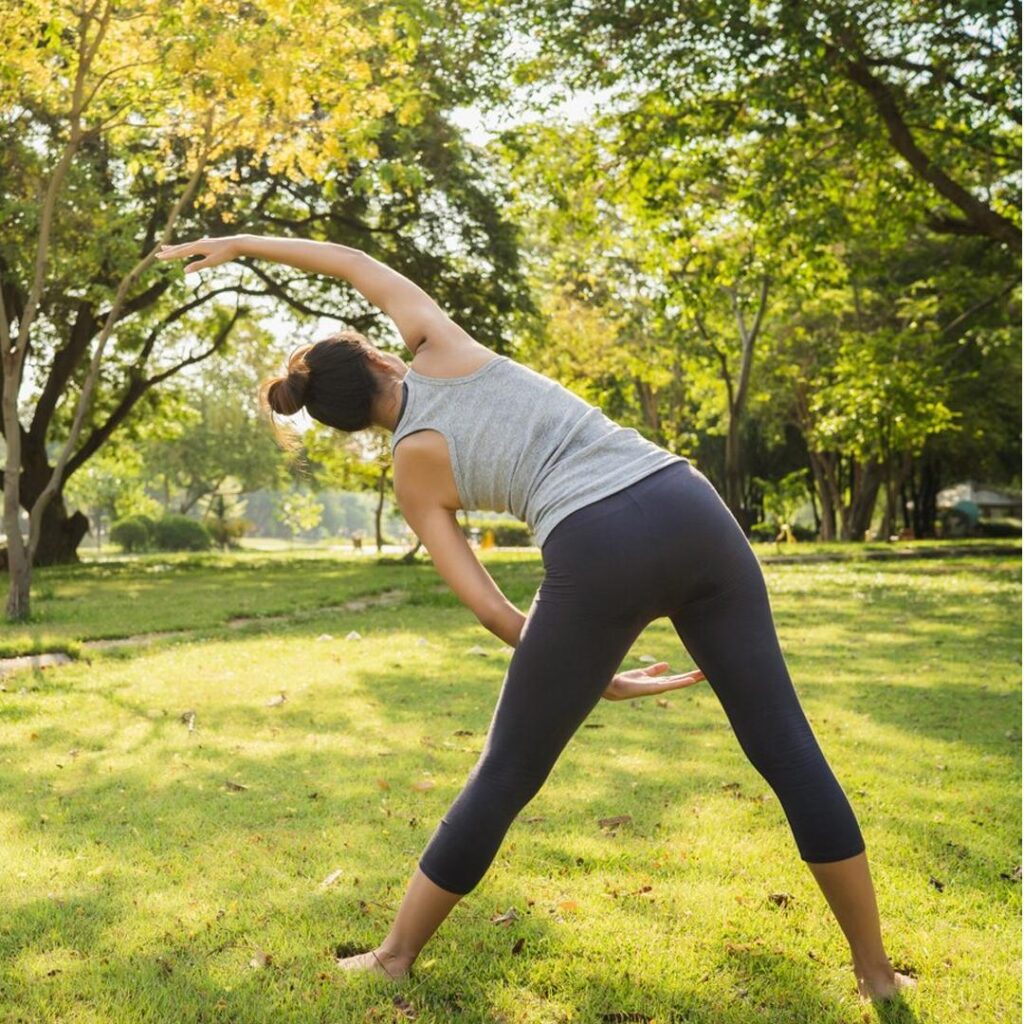In the midst of demanding schedules, many moms face continuous problems, their days overflowing with responsibilities, often neglecting essential self-care practices. This lifestyle can trigger high cortisol levels, impacting physical, emotional, and mental health negatively. Enter the trampoline—a surprisingly fun and effective tool for stress relief. Cortisol, often referred to as the “stress hormone,” plays a crucial role in how our bodies respond to stress.
For busy moms, managing cortisol levels is essential for their well-being and ability to care for their families effectively. High cortisol can sap your energy, disturb your sleep, and even weaken your immune system, making the everyday hustle even more challenging.
Trampolining offers a unique blend of cardiovascular exercise and playful movement, making it an ideal activity for busy moms looking to reduce stress and boost their mood. In this blog, we’ll explore how bouncing on a trampoline can help manage cortisol levels and contribute to overall wellness, providing a practical and enjoyable solution for stress management.

Understanding Cortisol
Cortisol, often dubbed the “stress hormone,” is a steroid hormone produced by the adrenal glands located on top of each kidney. When you encounter a stressful situation, your body’s fight-or-flight response kicks in, prompting the release of cortisol into the bloodstream. This hormone helps regulate various functions, such as metabolism, blood sugar levels, and inflammation, preparing your body to handle stress effectively.
Cortisol plays a crucial role in maintaining your overall health. In the short term, it can enhance your body’s immune response and provide a quick energy boost. However, prolonged elevated cortisol levels, common in the hectic lives of busy moms, can lead to negative health effects. Chronic high cortisol can contribute to issues like anxiety, depression, digestive problems, weight gain, and even heart disease. It can also disrupt your sleep patterns, making it harder to get the rest you need to tackle daily challenges.
Busy lifestyles often mean continuous stress, whether it’s juggling work and family responsibilities, managing household chores, or dealing with unexpected events. This constant stress can keep cortisol levels elevated, creating a vicious cycle of fatigue and poor health. Understanding the link between stress and cortisol is the first step in managing it effectively.
Trampolining offers a fun and effective way to break this cycle. By incorporating regular, enjoyable exercise into your routine, you can help regulate your cortisol levels and improve your overall well-being. Next, we’ll learn why self care is essential for every mothers.
Self care is essential for mothers
Mother is everything, she is strength, she is the positive energy, a shield, a backbone and a most important member of the family. So, as a mother self-care is essential for you. When you prioritise self-care, you improve your mental health, lower the chances of diseases, and set a better example for your children. By taking time for yourself, you enhance your ability to cope with stress and maintain emotional balance. This not only benefits you but also positively impacts your family’s well-being.
Practising self-care can reduce the risk of chronic illnesses such as heart disease and diabetes. Staying healthy allows you to be more present and engaged in your family’s life, showing your children the importance of taking care of oneself.
Moreover, being a positive role model teaches your children to value their health and well-being. When they see you making time for exercise, relaxation, and healthy habits, they are more likely to adopt these practices themselves.
Now, let’s dive into the benefits of physical activity on cortisol levels and how it plays a crucial role in stress management.
Benefits of Physical Activity on Cortisol Levels

Engaging in regular physical activity is one of the most effective ways to manage and reduce cortisol levels. Exercise triggers the release of endorphins, often referred to as “feel-good” hormones, which help counteract stress and promote a sense of well-being. When you exercise, your body becomes better equipped to handle stress, leading to lower cortisol levels over time.
- Research consistently supports the benefits of exercise in cortisol reduction. Studies have shown that physical activity can significantly decrease cortisol levels, helping to mitigate the harmful effects of chronic stress. Regular exercise not only reduces cortisol but also improves overall mental health, enhances mood, and boosts energy levels, making it easier to cope with daily challenges.
- Various types of exercises have proven effective in reducing cortisol levels. Aerobic activities like walking, running, and cycling are particularly beneficial. These exercises increase your heart rate and promote cardiovascular health, which helps regulate cortisol production. Strength training, such as weight lifting, also contributes to cortisol reduction by improving muscle mass and metabolism.
- Mind-body exercises like yoga and Pilates combine physical movement with deep breathing and mindfulness, effectively lowering cortisol levels and promoting relaxation. These activities emphasise controlled breathing and gentle stretching, which can calm the nervous system and reduce stress hormones.
- Among these, inground trampoline stands out as a fun and effective way to reduce cortisol. It combines cardiovascular exercise with playful movement, making it an enjoyable activity that busy moms can easily incorporate into their routines. By adding trampolining to your fitness regimen, you can experience the benefits of reduced cortisol levels while having fun.
Next, we’ll explore the unique benefits of trampolining and how this enjoyable exercise specifically helps in managing cortisol levels and overall stress.
Trampolining: A Unique Exercise Approach

Trampolining, also known as rebounding, offers a unique and enjoyable approach to exercise. Unlike traditional workouts, trampolining involves bouncing on a mini-trampoline, which adds an element of fun and excitement to your fitness routine. This form of exercise is not only engaging but also highly effective for reducing stress and managing cortisol levels.
How Trampolining Differs from Traditional Forms of Exercise
- Low-Impact Workout: Easier on your joints compared to running or high-impact aerobics. The trampoline’s surface absorbs much of the impact, reducing the risk of injury.
- Full-Body Engagement: Engages multiple muscle groups simultaneously, offering a full-body workout that improves strength, balance, and coordination.
Potential Benefits of rebounding on Cortisol Levels
- Reduces Cortisol Levels: The rhythmic bouncing stimulates the lymphatic system, promoting detoxification and reducing inflammation. As you bounce, your body releases endorphins, which counteract the effects of cortisol and promote a sense of well-being.
- Improves Cardiovascular Health: Enhances heart health and boosts energy levels.
- Enhances Mental Clarity: The physical movement and endorphin release help to lower cortisol levels and reduce stress.
- Encourages Consistency: The playful nature of bouncing on a trampoline makes it a delightful way to exercise, motivating busy moms to stick with a regular fitness routine.
By incorporating trampolining into your daily schedule, you can effectively manage cortisol levels, boost your mood, and improve overall health.
Next, we’ll provide practical tips for busy moms on how to incorporate trampolining into their routines, ensuring safety and maximising the benefits of this unique exercise.
Practical Tips for Busy Moms

Incorporating trampolining into your busy schedule can be both fun and beneficial for managing stress. Here are some useful pointers to get you going:
Incorporating Trampolining into a Busy Schedule
- Short Sessions: You don’t need hours to benefit from a rectangle trampoline. Even 10-15 minutes of bouncing can have a positive impact on your mood and energy levels.
- Breaks Between Tasks: Use trampolining as a quick break between household chores or work tasks. A few minutes of bouncing can refresh your mind and body.
- Family Activity: Make trampolining a family affair. Involve your kids in the activity to spend quality time together while staying active.
Safety Considerations and Guidelines for Trampolining
- Choose the Right Trampoline: Ensure you have a high-quality family trampoline with a sturdy frame and non-slip surface.
- Proper Footwear: Wear supportive, trampoline socks or go barefoot to maintain good grip and balance.
- Start Slow: If you’re new to trampolining, start with gentle bounces and gradually increase intensity. Focus on maintaining good posture and balance.
- Clear Surroundings: Make sure the area around your trampoline is clear of obstacles to prevent accidents.
- Listen to Your Body: Pay attention to how your body feels. If you experience any pain or discomfort, stop and rest.
Other Lifestyle Changes That Complement Trampolining
- Healthy Diet: Eat a balanced diet rich in whole foods, including fruits, vegetables, lean proteins, and whole grains. Avoid excessive caffeine and sugar, which can elevate cortisol levels.
- Adequate Sleep: Prioritise getting 7-8 hours of quality sleep each night to help your body recover and manage stress better.
- Mindfulness Practices: Incorporate activities like meditation, deep breathing exercises, or yoga to further reduce stress and cortisol levels.
- Hydration: Drink plenty of water throughout the day to stay hydrated and support overall health.
By making these lifestyle changes and incorporating trampolining into your routine, you can effectively manage cortisol levels and improve your overall well-being.
Conclusion
Trampolining offers busy moms a joyful and effective way to manage stress and reduce cortisol levels. By incorporating this fun activity into your daily routine, you can boost your mood, improve your energy, and support your overall well-being. Remember, your health is crucial not only for you but for your family too. When you take care of yourself, you are better equipped to take care of those you love.
Explore the world of trampolining and make it a part of your wellness journey. It’s more than just exercise—it’s a playful escape that brings smiles and relief from the chaos of daily life. Embrace the bounce, feel the stress melt away, and let the endorphins lift your spirits.
We’d love to hear from you! Have you tried trampolining? Share your experiences and tips with other moms in the comments. Your journey to better health and stress management can inspire others.
Remember, your well-being matters. Make time for yourself, stay active, and let trampolining bring joy and balance into your busy life.
Engaging in moderate-intensity aerobic exercises like walking, jogging, or yoga can effectively reduce cortisol levels.
Practice mindfulness, take short breaks for relaxation, engage in light physical activity, and ensure adequate sleep to manage cortisol levels.
Activities such as deep breathing exercises, meditation, yoga, and spending time in nature can help calm down cortisol.
Staying hydrated is important for overall health, but there is no strong evidence that drinking a lot of water directly reduces cortisol levels.
Excessive cortisol can lead to symptoms like weight gain, especially around the abdomen, high blood pressure, muscle weakness, mood swings, and disrupted sleep.





